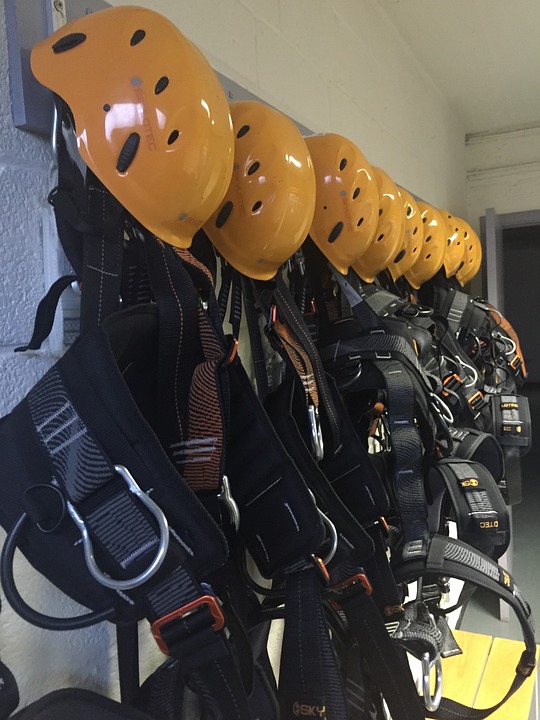Who Needs Working At Heights – Checklist & Quick Answers

If you are a worker or an employer, it’s important to know exactly who needs Working At Heights (WAH) training. As a worker, have you received required Working At Heights training? As an employer, have you provided required Working At Heights training? This article is designed to help you understand who is required to receive Working At Heights training. For more information about WAH training, contact ACUTE now!
Who Needs Working at Heights Training?

Ontario workplaces are divided into legislated sectors. Each sector is governed by sector-specific regulations that outline training requirements. Ontario Regulation 213/91 – Construction Projects governs construction work, including working at heights. Working At Heights training is mandatory for any construction project workers who use any of the following methods of fall equipment:
- A travel restraint system ✓
- A fall restricting system ✓
- A fall arrest system ✓
- A safety net ✓
- A work belt ✓
- A safety belt ✓
It is the employer’s responsibility to ensure that workers who may use fall protection systems receive proper Working At Heights training. Before a worker can work at heights, they must complete an approved training program delivered by an approved training provider.
Working At Heights Training Is Not Required For My Job – Should I Still Take It?

As mentioned above, workers working on construction projects and who use the above methods of fall equipment must receive Working At Heights training. However, other workers may benefit from Working At Heights training too. Any person who is exposed to fall hazards during their work could find WAH training beneficial.
Those working in industrial, mining, or health care sectors will find WAH course content helpful for their field. Keep in mind that although anyone can take the WAH course, Working At Heights training is geared towards those working on construction projects. For a shorter and more general course, check out ACUTE’s Fall Prevention training.
What Should I Expect During WAH Training?
Knowing what to expect during your first WAH training course can help you come prepared. The first question many have is, “How long is the Working At Heights course?” ACUTE’s WAH training course is one full day (8 hours), and then it’s done! ACUTE’s knowledgeable trainers have over 100 years of combined industry experience, ensuring participants receive only the best training. ACUTE combines theory with practical learning to provide participants with in-depth training.
When training with ACUTE, participants should come prepared to learn in a variety ways, including:
- Theory ✓
- Hands-on, practical training ✓
- Written Evaluation ✓
- Performance Evaluation ✓
Participants should also be aware of the WAH course objectives beforehand. Understanding the purpose of Working At Heights training can help you get the most out of your training program. The purpose of a Working At Heights course is to:
- Strengthen workplace safety culture by understanding the importance of preventing falls from heights
- Provide workers with adequate knowledge about fall hazards and general safety practices, allowing them to work safely at heights
- Provide workers who use fall protection equipment with sufficient knowledge about its purpose and use
- Reduce the number of fall-from-heights incidents, injuries, and fatalities
WAH training participants should have some understanding of the actual course content in order to be prepared and feel confident during the course. During ACUTE’s WAH course, you can expect to learn:

- Working At Heights legislation
- Working At Heights hazards
- Fall prevention systems and strategies
- Ladder safety
- A-B-C component selection, inspection, and use
- Harness inspection
- Travel restraint, fall arrest set-up exercise & evaluation
- Rescue plan – components and purpose
- And more – view ACUTE’s WAH course here
ACUTE’s Working at Heights Training
With over 100 years of combined experience, you can be sure to receive quality, hands-on training from knowledgeable and experienced staff. ACUTE’s Working at Heights course aims to strengthen workplace safety culture, provide adequate knowledge about fall hazards and prevention, provide workers with sufficient knowledge regarding the use of fall protection equipment, and reduce the number of fall-related incidents, injuries, and fatalities. Here are some of the differences when training with ACUTE:
- Open Door Instructor-Student Partnership – ACUTE’s training services emphasize client participation. Our staff
 want to build a relationship with clients and serve as a touchstone for advice anytime moving forward.
want to build a relationship with clients and serve as a touchstone for advice anytime moving forward. - Serving Your Team and Industry – With a vast array of clients in manufacturing, construction, health, academic, and government sectors, ACUTE brings the best safety practices from across the spectrum to your workplace.
- 100 Years Combined Experience – ACUTE provides comprehensive health and safety training, on-site safety services, and consulting services. With over 100 years of combined experience, our company staff offer more than theoretical or abstract ideas. ACUTE offers solutions.
- Track Record of Success – ACUTE is rated 4.9/5 stars on Google reviews, demonstrating a commitment to our clients, quality, and passion for training.
“For over 20 years, Ron Campbell and the professional team at Acute has helped us develop a continuously improving safety program customized to our unique needs in environmental testing and renewable energy services. We are proud of our safety culture and record supported by Acute training services.”
– Hank, Environmental Consulting Company, more testimonials here
Contact us today for quality training in your workplace or on-site at ACUTE’s proven training facilities!
ACUTE is located in Waterloo, Ontario, and services customers from the cities such as Toronto, Mississauga, Brampton, Hamilton, Milton, Kitchener, London, and Guelph, as well as other cities from across Ontario.

